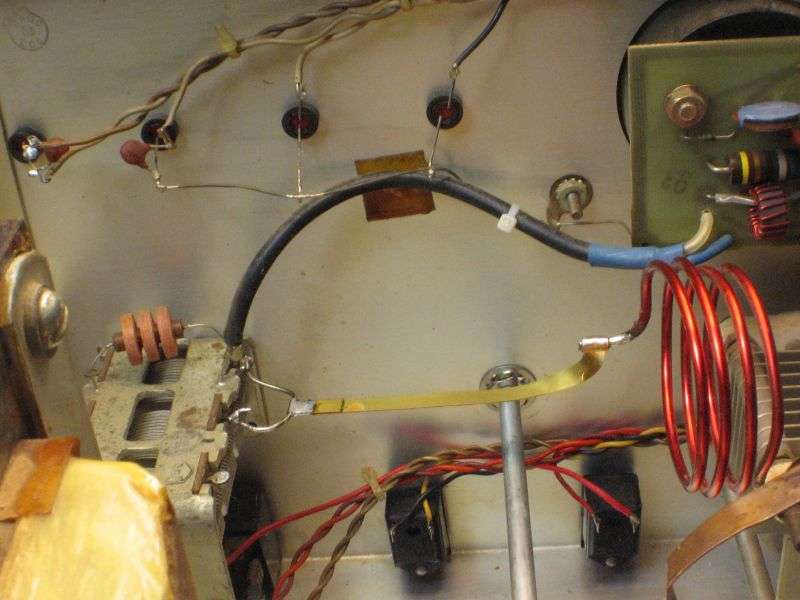The tube requires no more than 2000 volts on the plate so you need a transformer that has an AC secondary of 1350-1400 when using a capacitor type filter.
...Very true. RF Parts has a "stock" xformer.
BUT, the 250b's will take more voltage. I run them to about 2800, 3000 no load. They put out lots more suds, but you have to be more careful tuning them.
>True but why flirt with disaster. I prefer to believe the manufacturers specs.
______________________________
..........Eimac rates the 250 for more plate voltage and plate current. The pulse rated and standard rated tubes have the same internal structures, just spaced slightly farther apart on the external side (anode is moved further away from the other elements on the outside, preventing arcing). This in no way harms the tube, when running it at higher voltages in ICAS use.
______________________________
The plate current would be around 500 mA for a pair of tubes when properly run but for AM service I suggest a current rating of 1 amp for the transformer.
...Properly run? In the CB service? Not highly likely.
Spec your xformer for .5A CCS, or near 1 amp ICAS. And I look at that as a minimum.
> That's what I said,1 amp
The screen supply should be around 350 volts so you need a transformer with an AC secondary of around 250 volts.
...This I don't agree with. You lose regulation using a transformer that has a lower secondary rating than the voltage level you wish to get.
...IE, do you use a 12 VAC secondary for a 13 volt power supply?
> 350 is a ballpark figure. You can go +/- a bit and yes a 12 vac sec is good for a 13 vDC power supply depending on the current. It will yeild 18 volts preregulator.I used a 15 vac sec on a 40 amp supply with no loss of regulation. A screen supply does not draw all that much current.
______________________________
lol. That's not 18 volts rms... Your rms voltage will be .9 times the transformer output, when rectified. That means a lot of filter C to ensure it never drops below what you want.
And if your going to argue against my point, don't back my point up. You are trying to tell people that you can use a lower secondary voltage than the DC voltage reguired, then state in your own use, you use a higher secondary voltage! Unless, 15 volts somehow became lower than 13.8?
AND, 350 is NOT a ballpark figure, it is what the manufacturer spec'ed. YOU said you follow the spec's. With a grid driven tetrode, ESPECIALLY one with delicate grids like the 250 series, screen and grid voltage is MAJOR important. Hence the need for multiple taps you argue against below.
______________________________
...You want the best you can get, when you homebrew something. You usually spend more than you would purchasing new or used equipment, so it's either to get something better than is commercially available, or because you get a hard on watching your plate current meter peg the 5A scale

I suggest you do not tap off the plate supply with dropping resistors for the screen supply. It can be done but is not a good idea for AM or SSB service where the plate current is rather dynamic as it will cause fluctions in the screen voltage.
...Agreed.
I suggest you start looking at places like RFparts or Surpluss Sales of Nebraska unless you want to pay top dollar from Peter Dahl for the iron you need.
...Peter Dahl has some transformers spec'ed out exactly for what he wants, for amps I and a couple others in San Diego built in the 80s. Think Mudshack, if you look in their catalog. That store didn't do the amps, but they where the front

Do you really need dual voltage primary BTW? And what about the 5 and 10% taps?? Are they really necessary as well?
...No, but they are free. When you order a xformer from Dahl, why NOT get freebies? You are paying top dollar, and getting the best your money can purchase.. Why NOT get something better?
> Assuming of course the xmfr's are bought from PW Dahl.
______________________________
I seem to recall MC stating that this was a premium build up... Correcting the problems you find in commercial crap amps. And he was going to be purchasing the iron from a manufacturer. And if all of the above is true, PWDahl is the supplier of choice.
______________________________
...And yes, they are necessary....
>Nice maybe. Necessary no.
______________________________
If you want to follow your own guidelines of following the manufacturers spec's, you have to have a means of adjusting primaries. The voltage levels incoming in my house vary between all seasons, depending on whether or not AC is being used, cooking in the evenings, etc. It can cause + / - 5 VAC on the input. Move. You might find +15 volts, if you move to a different power grid. Now, all of a sudden, your fils are over voltage, your screen voltage is almost at maximum rated, and grid voltage is so high in reference to screen that the tube is being operated WAY out of ratings... Just about being run to full potential at IDLE!
Any other questions?
______________________________
Maybe a bit nice to have if being picky about setting voltages but the amp won't mind a bit of leeway.Generally big amateur amps and comercial stuff have a series of taps to compensate for local line voltage variations but they are far from necessary for homebrew projects.

